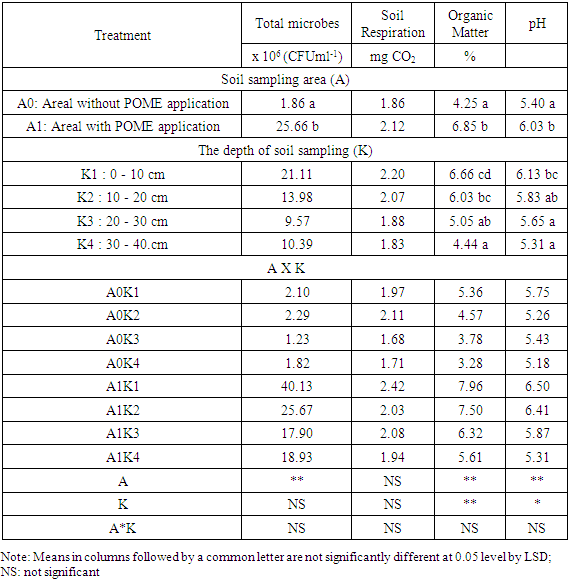-
Paper Information
- Paper Submission
-
Journal Information
- About This Journal
- Editorial Board
- Current Issue
- Archive
- Author Guidelines
- Contact Us
Resources and Environment
p-ISSN: 2163-2618 e-ISSN: 2163-2634
2018; 8(6): 245-249
doi:10.5923/j.re.20180806.02

The Effect of Palm Oil Mill Effluent on Total Microbes, Soil Respiration, Organic Matters and Soil pH in Oil Palm Plantation
Sakiah, Eka Bobby Febrianto, Andri Manurung
Department of Plantation Agriculture, STIPER-Agrobisnis Perkebunan (STIP-AP), Medan, Indonesian
Correspondence to: Sakiah, Department of Plantation Agriculture, STIPER-Agrobisnis Perkebunan (STIP-AP), Medan, Indonesian.
| Email: |  |
Copyright © 2018 The Author(s). Published by Scientific & Academic Publishing.
This work is licensed under the Creative Commons Attribution International License (CC BY).
http://creativecommons.org/licenses/by/4.0/

Waste utilization in oil palm plantations is an efforts manifestation by oil palm plantation businessman applying the zero waste concepts. The purpose of the research was to determine the total microbes, soil respiration, organic matter and soil pH in the application land and without the application of palm oil mill effluent in depth of 0-40 cm. The factorial randomized block design was used with three replications. The research results showed that POME application significantly affected the total microbes, organic matter and soil pH but had no significant effect on soil respiration. Soil sampling of different depths significantly affected the levels of organic matters and soil pH but had no significant effect on total microbes and soil respiration.
Keywords: Liquid waste, Oil palm, Microbes
Cite this paper: Sakiah, Eka Bobby Febrianto, Andri Manurung, The Effect of Palm Oil Mill Effluent on Total Microbes, Soil Respiration, Organic Matters and Soil pH in Oil Palm Plantation, Resources and Environment, Vol. 8 No. 6, 2018, pp. 245-249. doi: 10.5923/j.re.20180806.02.
Article Outline
1. Introduction
- Processing oil palm into palm oil produces large amounts of liquid waste [1], around 55% to 67% of the total fresh fruit bunches processed [2]. This fresh waste is in the form of a colloidal suspension consisting of 94-95% water, 0.7-1% oil and 4-5% total solids including floating solids of 2-4% [3]. Raw or unprocessed palm oil mill effluent (POME) has a high BOD value around 25,000 mgL-1 or more [4] hence the POME produced by palm oil companies must be processed in order to have no negative impact on humans or the environment. The characteristics of POME vary depending on the processing technique. Before being applied to the land, liquid waste is treated first at the Wastewater Disposal Installation Station (WWTP) and through several treatments so that it meets the quality standards of waste to be applied to the land [5]. Minimum requirements that must be fulfilled for the use of POME on land in oil palm plantations are the value of Biological Oxygen Demand (BOD) not exceeding 5,000 mgL-1, the pH value ranges from 6-9 and is carried out on land other than peatland [6]. This research aim was to determine the characteristics of palm oil mill effluent applied to oil palm plantations and to inventory the total microbes, soil respiration, organic matter content and soil pH in fields with POME application and without POME application at 0-10 cm, 10-20 cm, 20-30 cm and 30-40 cm depth. The distinctive feature of POME is the high organic matter content, thus allowing it to be utilized on oil palm plantations to avoid environmental pollution and overcome fertilizer needs [7]. Some research results indicated that the application of POME has a positive effect on soil fertility, both on the physical, chemical and biological properties of soil [8].
2. Materials and Methods
2.1. The Experiment
- This research used factorial randomized block design, factor 1: soil sampling area, consisting of POME application area and area without POME application, factor 2: depth of soil sampling, consisting of 0-10 cm depth, 10-20 cm depth, 20-30 cm depth and 30-40 cm depth. Each treatment was repeated three times. Sampling area with POME application treatment was in block E 14 and area without POME application was in block G 14, Pengarungan plantation, Asam Jawa Ltd, Torgamba, Sumatera Utara Province, Indonesia. In those areas, there were oil palm plantations planted in 1997 (20 years of plant life). Undisturbed soil samples were taken for analysis of soil respiration and microbial population [9-11], analysis of microbial population and soil respiration was carried out at the Laboratory of Soil Biology, Faculty of Agriculture, University of Sumatera Utara. Composite soil with a diagonal pattern was taken for analysis of organic matter content and soil pH [11], soil analysis was carried out at the STIPER-Agrobisnis Perkebunan's Soil & Fertilizer Laboratory, Medan - Indonesia. Parameter testing was arranged in the list of variance and the significant results were followed by the Least Significant Difference test at the level of 5% and 1%.
2.2. Observed Parameters
- a. Total soil microbes, the technique used to calculate total soil microbes is the dilution plating method (CFU ml-1)b. Respiration of soil by closed CO2 measurement method (mg CO2 day-1)c. Organic matter with Walkley and Black method (%)d. Soil pH by electrometry method
2.3. Data Analysis
- The collected data were analyzed and tested parameters that were arranged in the variance list, the significant results were followed by the Least Significant Difference test at the 5% and 1% levels.
3. Results and Discussions
3.1. Characteristics of Palm Oil Mill Effluent
- The POME that flowed comes from the primary anaerobic pond, using a tank truck application system as shown in Figures 1 and 2. POME application has been carried out since 2012, the application dose is 70 liters per plant, the frequency of watering is done twice per year so that each plant gets 140 liters.
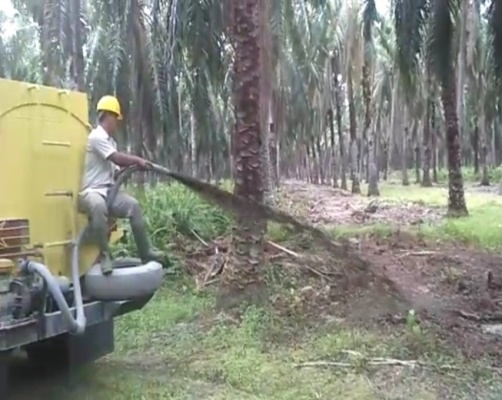 | Figure 1. Palm oil mill effluent application |
|
3.2. Total Microbes, Respiration Soil, Organic Matter and pH
- Statistical analysis of total microbes, soil respiration, organic matter and soil pH showed on Table 2.
|
3.3. Total Microbes
- Statistical analysis showed that the application of POME in the area of oil palm plantations significantly affected the total microbes, but the effect was not significant on the total microbes at depths of 0-10 cm, 10-20 cm, 20-30 cm and 30-40 cm. The interaction between the treatment of soil sampling area and the depth of soil sampling also did not significantly affect the total microbes (Table 2). The total soil microbes in the POME application area averaged in 25.66 x 106 CFU ml-1, higher than the total microbes in the area without the POME application which was 1.86 x 106 CFU ml-1. The POME application for oil palm plantations has a positive effect on total soil microbes, that POME application can improve soil health condition in the oil palm plantation. The treated POME application increased the amount of microorganism but did not change the diversity of microorganisms in soils [12]. Total soil microbes become an indicator of soil fertility, by knowing the number and activity of microbes in a soil, it can be seen whether the soil is fertile or not because of the high microbial population indicating sufficient food / energy supply, suitable temperature, availability of sufficient water, and soil ecological conditions that support microbial development [10]. Total microbes at 0-10 cm depth obtained 21.11 x 106 CFU ml-1, greater than other depths. The number of microorganisms in the soil is affected by various conditions, such as temperature, humidity, aeration and energy sources. But in general the largest population is found on the surface horizon, soil microorganisms are found more on the soil surface because organic matter is more available [13]. This can be seen in the interaction between the POME application area 0-10 cm (A1K1) sampling depth, in this treatment, the highest total microbes were found compared to other treatments, namely 40.13 x 106 CFU ml-1. The effect of POME application not only affects the total microbes but also increases the population of arthropods. Arthropods population is mostly found in the areas with palm oil mill effluent application by 642 individual (304.26% compared to areas without application), while in areas without application found as many as 211 individuals [14].
3.4. Soil Respiration
- Statistical analysis showed that the sampling area and the depth of soil sampling have no significant effect on soil respiration. Soil respiration in the POME application area averaged at 2.12 mg CO2, higher than in the area without POME application. In the treatment of sampling depth, the highest soil respiration was found at 0-10 cm depth which was 2.20 mg CO2 and the lowest was at a depth of 30-40 cm. Microbial activity is higher at the soil surface, this is due to the soil surface supporting environmental factors for microbial life. The interaction between the sampling area and the sampling depth (Table 2) showed that the highest respiration value was found in A1K1 treatment (POME application area with 0-10 cm depth) which is 2.42 mg CO2. Total microbes were positively correlated with soil respiration with a value of 0.76 [15]. The correlation between total microbes and soil respiration was shown in Figure 2. Soil respiration is one indicator of microbial activity in the soil, the level of respiration is an indicator of the rate of decomposition of organic matter that occurs at certain intervals [13, 16, 9].
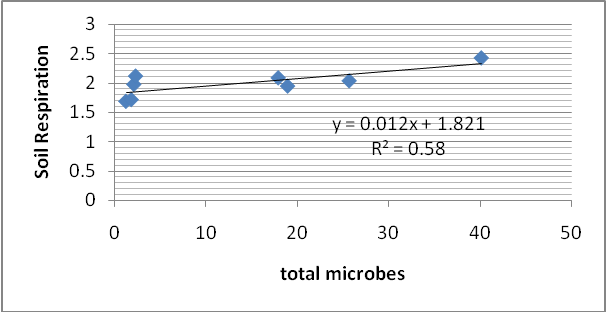 | Figure 2. Total microbial correlation with soil respiration in the application area and without the POME application at depths between 0-40 cm |
3.5. Organic Matter
- Statistical analysis showed that the treatment of the soil sampling area has a significant effect on the level of organic matter as well as the depth of soil sampling. The average rate of organic matter content in the POME application area was higher than in the area without the POME application. The average rate of organic matter in the application area of POME was 6.85% and in areas without POME application was 4.25%. In sampling based on depth, the highest organic matter was found at 0-10 cm depth, which was 6.66%, soil that contains a lot of humus or organic matter is topsoil. The deeper it goes to the soil bottom layer, the less organic matter content is, therefore topsoil must be maintained [17]. In the interaction treatment between the sampling area and the sampling depth, the highest organic material was found in A1K1 treatment (POME application area 0-10 cm depth) which was 7.96% and the lowest was in A0K4 treatment which was 3.28%. In this case proving that the POME with a BOD value of 1,360 mg L-1 applied to the oil palm plantation area is a source of organic matter for the soil. Palm oil mill effluent besides being a source of macro and micronutrients that are important for plants is also a source of organic matter which will also play a role in improving the chemical and physical properties of the soil, among others, increasing cation exchange capacity and soil porosity [18]. Besides functioning to increase cation exchange capacity and soil porosity, organic matter also contributes to total microbial increase. In Figure 2, there was a positive correlation between total microbes and soil organic matter. In this research, the correlation between total microbes and soil organic matter was 0.91 (perfect correlation). Soil organisms play a role in the decomposition of organic matter, distribution and mixing of organic matter and become an enemy to pathogens that attack plants. Soil organisms consist of microorganisms and fauna. Therefore the existence of soil organisms is very important in assisting plant growth and productivity. Although the size is very small, soil microorganisms are responsible for most biological processes (60-80%) related to nutrient cycling and decomposition of organic matter [19]. Palm oil mill effluent in addition to containing nutrients also contains quite a high amount of organic matter (C-Organic 3,072,15 mg l-1 equivalent to 2,3 kg tree-1 at a dose of 750 l tree-1). Furthermore, organic matter derived from liquid waste will affect the soil's elasticity, water retention capacity, and soil microorganism activity hence created a better growing environment for oil palm plants. The indirectly organic matter will affect the condition of the soil through the decomposition stage by soil organisms [20].
 | Figure 3. Total microbial correlation with soil organic matter in the application area and without POME application at depths between 0-40 cm |
3.6. Soil pH
- Statistical analysis showed that the treatment of the soil sampling area has a very significant effect on soil pH. The pH value of the soil in the POME application area averaged in 6.03 and in the area without application was 5.40 on average. The treatment of the depth of soil sampling had a significant effect on soil pH, the highest average pH was found at 0-10 cm depth which was 6.13 and gradually decreased at depths of 10-20 cm, 20-30 cm and 30-40 cm. The interaction between the sampling area and the sampling depth has no significant effect on soil pH. The soil pH value was lower in the area without the POME application than in the POME application area. The lowest pH value was found in AoK4 treatment (the area without POME application in 30-40 cm depth). The application of palm oil mill effluent at 750 L-1 can improve the quality of some soil chemical properties. Besides directly contributing in nutrients and soil pH, it can also indirectly contribute to soil nutrients through the process of mineralization of organic matter that has undergone decomposition. Due to the application of liquid waste, the pH of the soil increases [20]. The correlation between total microbes and soil pH was positively correlated with a correlation value of 0.81 (high degree of correlation). The importance of making pH as an indicator of soil fertility is to determine whether or not nutrients are absorbed by plants because at these pH nutrients are easily dissolved in water, showed the possibility of toxic elements because there are many Al ions found in the soil, which except fixing the P element is also toxic to plants, and the latter pH affects the development of microorganisms where the bacteria develop well at pH 5.5 or more, while at pH less than 5.5 the development is severely inhibited [17].
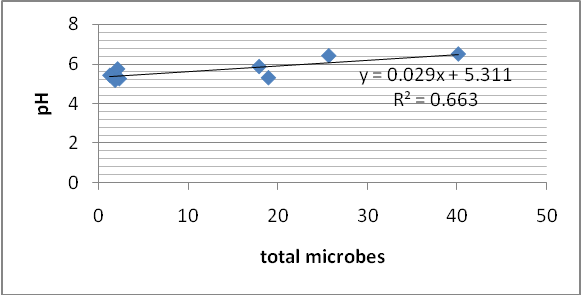 | Figure 4. Total microbial correlation with soil pH in the application area and without the POME application at a depth of 0-40 cm |
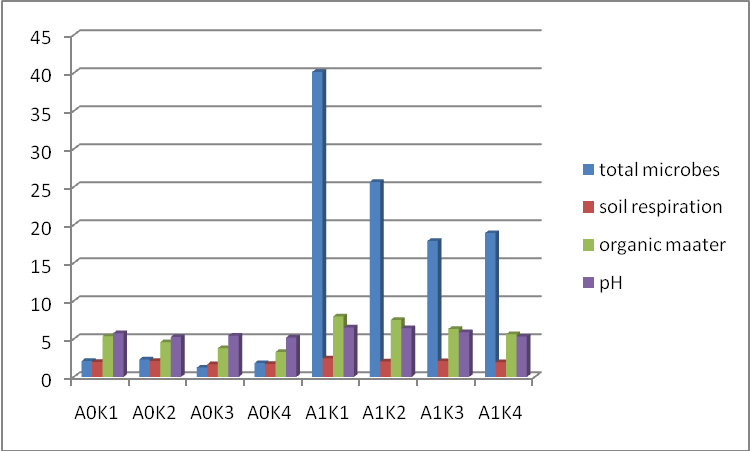 | Figure 5. The average rate of total microbes, soil respiration, organic matter and soil pH |
4. Conclusions
- Application of palm oil mill effluent with a BOD value of 1,360 mg l-1, COD 3,048.75 mg l-1 and pH 7.48 which was applied with the tank truck system at 140 liters/ plant/year, had an effect on increasing; total microbial, soil respiration, organic matter content and soil pH. Total microbes with soil respiration has a perfect correlation, the correlation coefficient value is 0.76. Total microbes with organic matter and soil pH has a high degree of correlation. The correlation coefficient value of total microbes with organic matter is 0.91 and with pH is 0.81.
 Abstract
Abstract Reference
Reference Full-Text PDF
Full-Text PDF Full-text HTML
Full-text HTML
